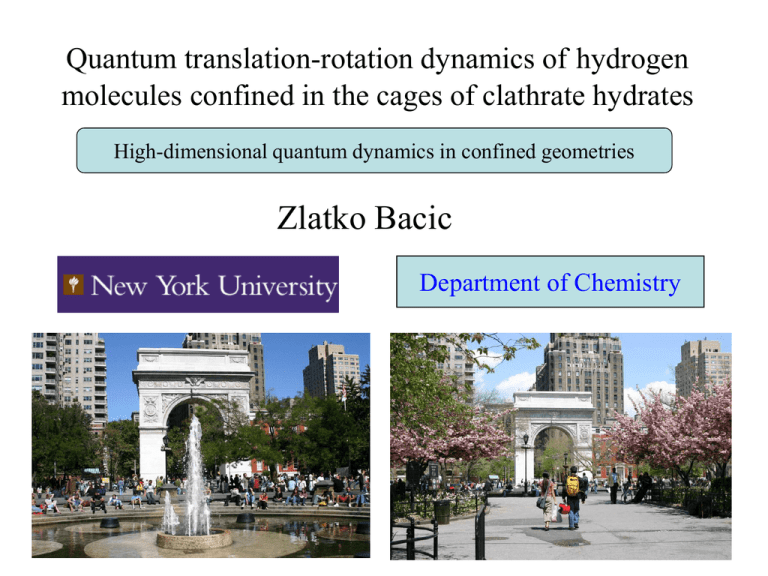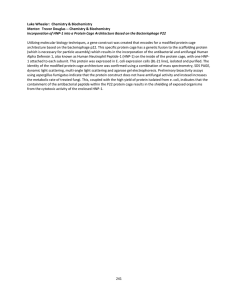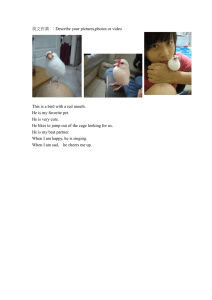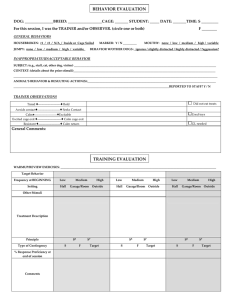Quantum translation-rotation dynamics of hydrogen
advertisement

Quantum translation-rotation dynamics of hydrogen molecules confined in the cages of clathrate hydrates High-dimensional quantum dynamics in confined geometries Zlatko Bacic Department of Chemistry COLLABORATORS • • • • • • Dr. Francesco Sebastianelli Dr. Minzhong Xu Yael Elmatad Dalal K. Kanan Prof. Jules W. Moskowitz FUNDING: NSF, ACS-PRF M.Xu et al., JPC B 110, 24806 (2006) F. Sebastianelli et al., JPC C 111, 2497 (2007) F. Sebastianelli et al., to appear in JPC A, July 19, 2007 Introduction • Clathrate hydrates are inclusion compounds which incorporate guest molecules inside the polyhedral cages of the host framework made up of hydrogen-bonded water molecules. • Recently, clathrate hydrates have been synthesized with hydrogen molecules as guests (W. L. Mao et al., Science, 2002), at high pressures (~200 Mpa) and low temperatures (~250 K). – They have the classical structure II (sII), and are comprised of small dodecahedral (512) and large hexakaidecahedral (51264) cages, consisting of 20 and 28 water molecules, respectively. • Initially, it was estimated that 2 H2 molecules occupy the small cage, while 4 H2 molecules occupy the large cage, suggesting that the hydrogen hydrate may be a promising hydrogen storage material. – Subsequent neutron diffraction studies (K. A. Lokshin et al., PRL, 2004) confirmed the quadruple D2 occupancy of the large cage, but found only one D2 molecule in the small cage. Geometries of the small and the large cages Small dodecahedral (512) cage 20 H2O molecules Large hexakaidecahedral (51264) cage 28 H2O molecules • • Hydrogen molecules confined inside the clathrate cages constitute a highly quantum mechanical system, due to their large zero-point energy of their translational and rotational motions and wave function delocalization. Consequently, hydrogen hydrates provide an opportunity for investigating the intriguing behavior of quantum species in confined geometries. – Confinement in cages of different shapes and sizes is expected to give rise to novel quantum dynamical phenomena. • • Quantitative description of the quantum dynamics of hydrogen molecules in confinement can be achieved only by solving exactly the multidimensional Schrödinger equation for the coupled translation-rotation (T-R) motions of the guest molecule(s). In our calculations, the small and the large cages are assumed to be rigid, while the quantum T-R dynamics of the guest H2/D2 molecule(s) is treated rigorously, as fully coupled. – The guest hydrogen molecule is much lighter than either cage. – The interaction of the hydrogen molecule with the cage is much weaker than the hydrogen bonds between the framework H2O molecules. • The water molecules of the cage are each hydrogen bonded to three neighboring molecules, creating a fairly rigid framework. • • The positions of the O atoms of the framework water molecules are known from the X-ray diffraction experiments (T. C. W. Mak and R. K. McMullan, JCP, 1964). However, the H atoms of the water molecules are configurationally disordered. There is one H atom on each edge of the cage, forming a hydrogen bond between the O atoms at the corners connected by the edge. – In both the small and the large cage, a half of the water molecules are double donors, i.e., donate both their H atoms to the hydrogen bonds with two neighboring O atoms. The other half are single donors, whose one O-H bond is free. – The number of possible hydrogen-bonding arrangements is large. For the small 512 cage, it exceeds 30000 (S. McDonald et al., JPC A, 1998). • Several arrangements were chosen at random, having a different number of neighboring pairs of single-donor water molecules. • The potential energy surface (PES) for n H2 molecules inside the cage, large or small, is assumed to be additive: n n i1 i j V (Q) VH 2 cage (qi ) VH 2 H 2 (ij ) • The first term, the 5D PES for a (rigid) H2 molecule inside the cage, is pairwise additive, generated by summing over the interactions between H2 and of the 20 (28) H O molecules forming the small (large) cage. each 2 – For the pair interaction between H2 and H2O, we use the ab initio 5D (rigid monomer) PES for the H2-H2O complex (M. P. Hodges et al., JCP, 2004), whose global minimum is at -240.8 cm-1. • The H2-H2 pair potential is described by the ab initio 4D (rigid monomer) PES of the dimer (P. Diep and J. K. Johnson, JCP, 2000). Its global minimum lies at -40.00 cm-1. • • For a single encapsulated H2 or D2 molecule, accurate quantum 5D calculations of (>100 highly converged) T-R energy levels and wave functions are performed, by diagonalizing the 5D T-R Hamiltonian matrix; all three translational (x,y,z) and the two rotational (,) degrees of freedom are treated explicitly, as fully coupled. For two or more confined p-H2 or o-D2 molecules, their ground-state properties, energetics and spatial distribution inside the cage, are calculated rigorously using the diffusion Monte Carlo (DMC) method. Three different hydrogen-bonding configurations of the large cage 1D potential cuts through the 5D PESs of H2 in the small and the large cages 3D isosurfaces of the PES of H2 in the small cage Translational components of the 5D (j=0) T-R eigenstates of p-H2 in the small cage: I (0,0,0) 0.0 cm-1 (1,0,0) 52.6 cm-1 (2,0,0) 119.3 cm-1 (0,2,0) 154.6 cm-1 (0,1,0) 66.9 cm-1 (0,0,2) 184.4 cm-1 (0,0,1) 82.4 cm-1 Translational components of the 5D (j=0) T-R eigenstates of p-H2 in the small cage: II (3,0,0) 198.2 cm-1 (4,0,0) 287.4 cm-1 (?,?,?) 318.8 cm-1 (?,?,?) 363.5 cm-1 Translational components of the 5D (j=0) T-R eigenstates of p-H2 in the large cages Large cage 1 Large cage 2 T-R energy levels of o-H2 in the small cage Splitting of the j=1 triplet o-H2/p-H2 energy separation is 91.29 cm-1, smaller than 2B = 118.64 cm-1 in the gas phase. 1D and 3D probability distribution functions for one and two p-H2/o-D2 molecules in the small cage P(x,y,z) for n = 1, 2 p-H2 1D and 3D probability distribution functions for one and two p-H2/o-D2 molecules in the large cages P(x,y,z) for n = 2 p-H2 Large cage 1 Large cage 2 DMC ground-state energies for n = 1- 4 p-H2/o-D2 molecules in the large cages Large cage 1 Large cage 2 Large cage 4 Minimum-energy configurations of four H2 molecules in the large cages Large cage 1 Large cage 2 Large cage 4 1D and 3D probability distribution functions for four o-D2 molecules in the large cages P(x,y,z) for n = 4 o-D2 Large cage 1 Large cage 2 Large cage 4



